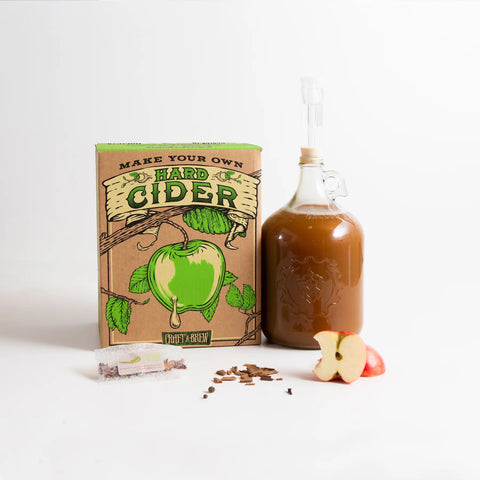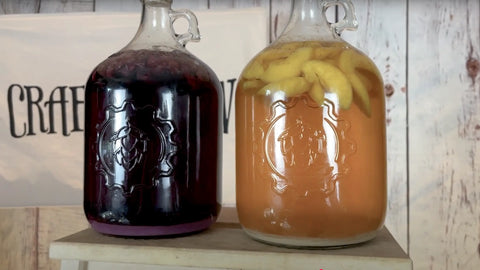TL;DR: Flavoring Your Cider
Hard cider is a simple, versatile base that can be endlessly customized. Whether you prefer cozy spices, fruity depth or sweetness, there are countless ways to experiment. This guide explores how to flavor hard cider with the best spices for cider, creative fruit additions, and even hop-forward twists to inspire your next batch.
Why Flavor Your Cider?
Hard cider is refreshing on its own, but its neutral base makes it the perfect canvas for creativity. After fermentation, cider no longer tastes like sweet apple juice—yeast converts those sugars into alcohol, leaving you with a crisp, dry and relatively basic drink. That’s where flavoring cider comes in. With the right additions, you can create:
-
Seasonal spiced hard ciders
-
Dry-hopped hard ciders
-
Fruity hard ciders
-
Easy-drinking sweet cders
-
Bright, tart hard ciders
Whether you want balance, sweetness, or bold complexity, cider is a brewer’s playground.
Spiced Hard Cider
Spices have been used for centuries in fermented drinks, and they remain some of the best spices for cider today. They layer warmth, depth, and aroma over apple’s natural tartness.
How to Flavor Hard Cider with Spices
-
In the fermenter – Use whole spices inside a sanitized straining bag. This keeps sediment contained and makes it easy to remove the spices once you’ve reached the desired flavor. Wait until fermentation slows to preserve aromatic oils.
-
As an extract or tincture – Infuse spices in vodka or another neutral spirit for 24–36 hours, then add the flavored liquid at bottling. This gives you precise control over dosage.
The Best Spices for Cider
-
Cinnamon sticks – Sweet, warming, and classic. Use 1–2 sticks per gallon.
-
Cloves – Potent, so use sparingly.
-
Nutmeg – Nutty, earthy, and aromatic.
-
Ginger – Zesty heat and freshness.
-
Allspice – A “three-in-one” flavor of cinnamon, nutmeg, and clove.
These timeless flavors make excellent homemade cider flavors for the holidays or cool weather.
Hopped Hard Cider
Hopped cider is a trend that bridges beer and cider lovers. Adding hops creates cider recipe ideas with floral, tropical, or citrusy layers. Unlike a heavily hopped IPA, a hop-infused cider showcases fruity hop flavor and aroma, without the intense, heavy bitterness.
How to Make Hop-Infused Cider
For hop aroma & flavor without bitterness, “dry-hop” during secondary fermentation (once fermentation calms down) to preserve delicate hop aroma. We like to add hops after 10 days of fermentation and bottle after 3 days.
Use 0.25–1 oz of hop pellets per gallon inside a straining bag. This keeps hop debris out of your bottles while giving you a clean, bright flavor.
The Best Hops for Hard Cider
-
Cascade – Grapefruit and floral.
-
Citra – Bold tropical citrus.
-
Amarillo – Orange zest and floral.
-
Saaz – Mild spice and earthiness.
Hop additions are a great example of how to flavor hard cider if you want something refreshing yet modern.
Fruited Hard Cider
If you prefer your hard cider with a fruity twist, fruit juice is one of the easiest and most impactful fruit additions for cider. Unlike whole fruit, fruit purees or fruit nectars, fruit juice doesn’t add much sediment, so you’ll maximize yield.
Flavoring Cider with Fruit Juice
Use at least 50% apple juice to retain a cider backbone + up to 50% other fruit juice. Here are some examples of homemade cider flavors following this formula:
-
0.5 gallon Apple Juice + 0.5 gallon Cranberry Juice
-
0.75 gallon Apple Juice + 0.25 gallon Tart Cherry Juice
The Best Fruit Additions for Cider
The juice aisle at your grocery store is full of cider recipe ideas waiting to happen! Here are some of our favorite flavors:
-
Cranapple or cranberry juice
-
Pear juice
-
Pomegranate juice
-
Tart cherry juice
-
Peach juice
-
Mango juice
Sweet or Tart Hard Cider
After fermentation, a hard cider won’t taste like the sweet juice you started with. The yeast convert sugars into alcohol for a dry finish. Once your cider has fermented, you can tailor sweetness and acidity to match your taste. If you prefer something sweet, or something with a tart apple bite, you can adjust this after fermentation!
How To Sweeten Hard Cider
Adding plain sugar won’t make cider sweeter—yeast will eat it and turn it into alcohol, leaving your cider even drier. To retain sweetness, you need a non-fermentable sugar.
Erythritol is an excellent choice. It has a clean, neutral sweetness very similar to sugar, but yeast can’t metabolize it. This means your cider stays sweet without affecting fermentation or carbonation.
-
Sweet cider: Add 2 tablespoons of erythritol per 12 oz bottle.
-
Semi-sweet cider: Add 1 tablespoon per 12 oz bottle.
Tip: Dissolve erythritol in a small amount of warm water or cider before adding to ensure even sweetness.
How To Add Acidity to Hard Cider
Acidity adds structure, complexity, and brightness. If your cider tastes flat, dull, or overly sweet, a small acid adjustment after fermentation can make a big difference.
Malic acid is the primary acid in apples, giving a natural green-apple tang.
Add a small pinch per gallon after fermentation is complete, wait 24 hours, taste, and adjust gradually to achieve your desired tart punch.
Balancing sweet and tart in this way lets you craft ciders that range from lightly crisp to bold and refreshing, while keeping the flavors layered and approachable.
When to Add Flavorings: Fermentation vs. Post-Fermentation
-
Primary fermentation: Best for integrated, subtle flavors like fruit juice.
-
Secondary fermentation: Ideal for preserving spices or hop aromas; add after activity calms down (2–3 days).
-
Post-fermentation: Use for backsweetening, extracts, tinctures, or acid adjustments for maximum control.
Final Thoughts: Endless Cider Creativity
From cinnamon-spiced fall ciders to juicy cherry blends or modern hop-infused cider, flavoring cider is all about experimentation. Start with a simple spice or fruit blend, then branch out into more adventurous combinations until you find your perfect homemade cider flavors.
👉 Ready to experiment? Check out our Cider Brewing Kits and Cider Recipe Refills—the perfect starting point for building your own library of homemade cider flavors.





